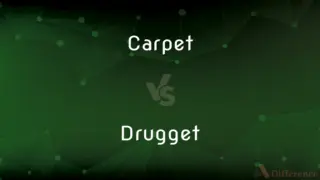Manatee vs. Walrus — What's the Difference?
Edited by Tayyaba Rehman — By Fiza Rafique — Updated on November 6, 2023
Manatees are large, mostly herbivorous, aquatic mammals with paddle-like tails, while walruses are tusked, carnivorous, and have flippered limbs.

Difference Between Manatee and Walrus
Table of Contents
ADVERTISEMENT
Key Differences
Manatees, often referred to as sea cows, are gentle, slow-moving aquatic mammals with bodies that taper to a flat, paddle-shaped tail. They are primarily herbivorous, feeding on sea grasses and freshwater vegetation. Walruses, in contrast, are distinguished by their prominent tusks, whiskers, and large, flippered bodies. They are mostly found in the Arctic and are carnivorous, preying on clams, mollusks, and other small marine animals.
The habitat of the manatee includes the warm waters of shallow rivers, bays, estuaries, and coastal waters, largely in the southeastern United States, the Amazon Basin, and West Africa. Walruses prefer the cold waters of the Arctic Ocean and the subarctic seas of the Northern Hemisphere. They rest on the ice floes and beaches when not in the sea.
Manatees have smooth, wrinkled skin, usually gray or brown, with sparse hair covering their bodies. They do not have external ear flaps. The walrus's skin is thicker, with a pink to brownish tint, and is nearly hairless. They have long tusks that are actually elongated canine teeth, which can be up to 3 feet in length and are present in both males and females.
When it comes to social behavior, manatees are typically solitary creatures, although they may gather in small groups. Walruses, however, are more social animals and are often found in large herds. During breeding season, these herds can number in the thousands.
The conservation status of both species is a concern, with manatees listed as vulnerable due to threats like habitat destruction and boat collisions. Walruses are not currently endangered, but they face threats from climate change, which affects their icy habitat.
ADVERTISEMENT
Comparison Chart
Habitat
Warm rivers and coastal waters.
Cold Arctic seas and ice floes.
Diet
Herbivorous, eating plants.
Carnivorous, eating marine invertebrates.
Physical Characteristics
Smooth, gray/brown skin, paddle tail.
Thick skin, tusks, whiskers.
Social Structure
Solitary or in small groups.
Large herds, especially during breeding.
Conservation Status
Vulnerable, with habitat loss threats.
Not endangered but threatened by climate change.
Compare with Definitions
Manatee
Often called sea cows, manatees are gentle herbivores.
Manatees were seen grazing on the abundant seagrass.
Walrus
Walruses are adapted to cold Arctic environments.
A walrus was spotted lounging on a floating piece of Arctic ice.
Manatee
Manatees inhabit warm waters and lack natural blubber.
Due to their low metabolic rate, manatees require warm water environments.
Walrus
A large marine mammal with distinctive tusks and whiskers.
The walrus used its long tusks to haul out onto the ice.
Manatee
A large, slow-moving aquatic mammal with a paddle-shaped tail.
The manatee glided gracefully through the shallow waters of the bay.
Walrus
Known for their ivory tusks, walruses are sometimes hunted.
Conservation efforts are in place to protect walruses from tusk poaching.
Manatee
These creatures are known for their friendly nature.
A group of snorkelers watched in delight as a manatee approached.
Walrus
This mammal has a thick layer of blubber for insulation.
The thick blubber of the walrus is essential for surviving Arctic temperatures.
Manatee
Manatees have a smooth, gray skin and are mostly hairless.
The manatee’s skin was dotted with scars from boat propellers.
Walrus
Walruses are social animals and often form large herds.
On the remote beach, a herd of walruses gathered to rest.
Manatee
Any of various herbivorous aquatic mammals of the genus Trichechus, having paddlelike front flippers and a horizontally flattened tail and found in warm coastal waters and rivers in Florida, northern South America, West Africa, and the Caribbean.
Walrus
The walrus (Odobenus rosmarus) is a large flippered marine mammal with a discontinuous distribution about the North Pole in the Arctic Ocean and subarctic seas of the Northern Hemisphere. The walrus is the only living species in the family Odobenidae and genus Odobenus.
Manatee
Manatees (family Trichechidae, genus Trichechus) are large, fully aquatic, mostly herbivorous marine mammals sometimes known as sea cows. There are three accepted living species of Trichechidae, representing three of the four living species in the order Sirenia: the Amazonian manatee (Trichechus inunguis), the West Indian manatee (Trichechus manatus), and the West African manatee (Trichechus senegalensis).
Walrus
A large marine mammal (Odobenus rosmarus) of Arctic regions, related to the seals and having two long tusks, tough wrinkled skin, and four flippers.
Manatee
Any of several plant-eating marine mammals, of family Trichechidae, found in tropical regions.
Walrus
A large Arctic marine mammal related to seals and having long tusks, tough, wrinkled skin, and four flippers, Odobenus rosmarus.
Manatee
Any species of Trichechus, a genus of sirenians; - called also sea cow.
Walrus
A man with a walrus moustache.
Manatee
Sirenian mammal of tropical coastal waters of America; the flat tail is rounded
Walrus
To hunt walruses
Walrus
To be like a walrus
Walrus
To move dragging one's belly along the floor
Walrus
To hang like a walrus's moustache
Walrus
To be prominent, like tusks
Walrus
A very large marine mammal (Trichecus rosmarus) of the Seal family, native of the Arctic Ocean. The male has long and powerful tusks descending from the upper jaw. It uses these in procuring food and in fighting. It is hunted for its oil, ivory, and skin. It feeds largely on mollusks. Called also morse.
Walrus
Either of two large northern marine mammals having ivory tusks and tough hide over thick blubber
Common Curiosities
Where can I see manatees in the wild?
Manatees can be seen in coastal waters of Florida, in the Caribbean, and in the Amazon Basin.
Are walruses endangered?
Walruses are not currently classified as endangered, but they are considered to be at risk due to climate change.
How long can a walrus's tusks grow?
A walrus's tusks can grow up to about 3 feet in length.
What are the biggest threats to manatees?
The biggest threats to manatees include habitat destruction, boat collisions, and entanglement in fishing gear.
Are manatees intelligent?
Manatees are considered to have moderate intelligence; they demonstrate complex learning and social behaviors.
How do manatees communicate?
Manatees communicate using a range of sounds like squeaks, squeals, and chirps, especially between mothers and calves.
What do manatees eat?
Manatees are herbivores and primarily eat water grasses and algae.
Do manatees have any natural predators?
Adult manatees have few natural predators, but calves may be preyed upon by sharks, crocodiles, and orcas.
What is the lifespan of a walrus?
Walruses can live up to 40 years in the wild.
What is the social structure of walruses?
Walruses are highly social and form large herds, especially during the breeding season.
Can manatees survive in cold water?
Manatees cannot survive in cold water for extended periods; they need warm waters to maintain their body temperature.
How do walruses use their tusks?
Walruses use their tusks for defense, dominance displays, and to help haul themselves out of the water onto ice.
Is it legal to hunt manatees?
Manatees are protected by law and it is illegal to hunt them.
Do walruses migrate?
Walruses may migrate with the ice floes, following their food sources and seeking optimal breeding grounds.
What kind of habitats do walruses need?
Walruses need sea ice platforms for breeding, birthing, and resting, as well as access to shallow waters for feeding.
Share Your Discovery

Previous Comparison
Bent vs. Dent
Next Comparison
Carpet vs. DruggetAuthor Spotlight
Written by
Fiza RafiqueFiza Rafique is a skilled content writer at AskDifference.com, where she meticulously refines and enhances written pieces. Drawing from her vast editorial expertise, Fiza ensures clarity, accuracy, and precision in every article. Passionate about language, she continually seeks to elevate the quality of content for readers worldwide.
Edited by
Tayyaba RehmanTayyaba Rehman is a distinguished writer, currently serving as a primary contributor to askdifference.com. As a researcher in semantics and etymology, Tayyaba's passion for the complexity of languages and their distinctions has found a perfect home on the platform. Tayyaba delves into the intricacies of language, distinguishing between commonly confused words and phrases, thereby providing clarity for readers worldwide.















































